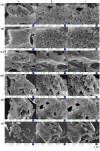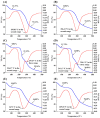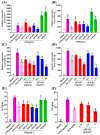Study of the Structure and Bioactivity of Polysaccharides from Different Parts of Stemona tuberosa Lour
- PMID: 38542983
- PMCID: PMC10975339
- DOI: 10.3390/molecules29061347
Study of the Structure and Bioactivity of Polysaccharides from Different Parts of Stemona tuberosa Lour
Abstract
The polysaccharides from Stemona tuberosa Lour, a kind of plant used in Chinese herbal medicine, have various pharmacological activities, such as anti-inflammatory and antioxidant properties. However, the effects of the extraction methods and the activity of polysaccharides from different parts are still unknown. Therefore, this study aimed to evaluate the effects of different extraction methods on the yields, chemical compositions, and bioactivity of polysaccharides extracted from different parts of Stemona tuberosa Lour. Six polysaccharides were extracted from the leaves, roots, and stems of Stemona tuberosa Lour through the use of hot water (i.e., SPS-L1, SPS-R1, and SPS-S1) and an ultrasound-assisted method (i.e., SPS-L2, SPS-R2, and SPS-S2). The results showed that the physicochemical properties, structural properties, and biological activity of the polysaccharides varied with the extraction methods and parts. SPS-R1 and SPS-R2 had higher extraction yields and total sugar contents than those of the other SPSs (SPS-L1, SPS-L2, SPS-S1, and SPS-S2). SPS-L1 had favorable antioxidant activity and the ability to downregulate MUC5AC expression. An investigation of the anti-inflammatory properties showed that SPS-R1 and SPS-R2 had greater anti-inflammatory activities, while SPS-R2 demonstrated the strongest anti-inflammatory potential. The results of this study indicated that SPS-L1 and SPS-L2, which were extracted from non-medicinal parts, may serve as potent natural antioxidants, but further study is necessary to explore their potential applications in the treatment of diseases. The positive anti-inflammatory effects of SPS-R1 and SPS-R2 in the roots may be further exploited in drugs for the treatment of inflammation.
Keywords: Stemona tuberosa Lour; biological activities; different extraction methods; physicochemical and structural properties; polysaccharides.
Conflict of interest statement
Author Hongwei Ma was employed by the company Guangdong Huakangyuan Medicinal Materials Resources Development Co., Ltd. The remaining authors declare that the research was conducted in the absence of any commercial or financial relationships that could be construed as a potential conflict of interest.
Figures








Similar articles
-
Isolation, characterization and anti-inflammatory effect of alkaloids from the roots of Stemona tuberosa Lour.Phytochemistry. 2024 Apr;220:114013. doi: 10.1016/j.phytochem.2024.114013. Epub 2024 Feb 7. Phytochemistry. 2024. PMID: 38331134
-
Absolute structures of stemona-lactam S and tuberostemospiroline, alkaloids from stemona tuberosa.Chem Pharm Bull (Tokyo). 2013;61(10):1085-9. doi: 10.1248/cpb.c13-00454. Chem Pharm Bull (Tokyo). 2013. PMID: 24088701
-
Anti-inflammatory activity and underlying mechanism against sepsis-induced acute lung injury of a low-molecular-weight polysaccharide from the root of Stemona tuberosa Lour.Int J Biol Macromol. 2024 Dec;282(Pt 1):136617. doi: 10.1016/j.ijbiomac.2024.136617. Epub 2024 Oct 18. Int J Biol Macromol. 2024. PMID: 39426768
-
The traditional uses, phytochemistry, and pharmacology of Stemona species: A review.J Ethnopharmacol. 2021 Jan 30;265:113112. doi: 10.1016/j.jep.2020.113112. Epub 2020 Jul 26. J Ethnopharmacol. 2021. PMID: 32726680 Review.
-
Isolation, structural properties and bioactivities of polysaccharides from Crataegus pinnatifida.J Ethnopharmacol. 2024 Apr 6;323:117688. doi: 10.1016/j.jep.2023.117688. Epub 2023 Dec 29. J Ethnopharmacol. 2024. PMID: 38159827 Review.
Cited by
-
Microscopic Identification, Phytochemical Analysis, and Study of Antioxidant Properties of Branches, Leaves, and Fruits of Kazakh Medicine Sambucus sibirica.Molecules. 2024 Nov 21;29(23):5503. doi: 10.3390/molecules29235503. Molecules. 2024. PMID: 39683662 Free PMC article.
-
Polysaccharides from Medicinal Plants: Bridging Ancestral Knowledge with Contemporary Science.Plants (Basel). 2024 Jun 21;13(13):1721. doi: 10.3390/plants13131721. Plants (Basel). 2024. PMID: 38999561 Free PMC article. Review.
-
Structural Characterizations and Biological Evaluation of a Natural Polysaccharide from Branches of Camellia oleifera Abel.Pharmaceuticals (Basel). 2025 Jan 3;18(1):51. doi: 10.3390/ph18010051. Pharmaceuticals (Basel). 2025. PMID: 39861114 Free PMC article.
References
-
- Wang L., Wu H., Liu C., Jiang T., Yang X., Chen X., Tang L., Wang Z. A review of the botany, traditional uses, phytochemistry and pharmacology of Stemonae Radix. Phytochem. Rev. 2021;21:835–862. doi: 10.1007/s11101-021-09765-1. - DOI
MeSH terms
Substances
Grants and funding
LinkOut - more resources
Full Text Sources

